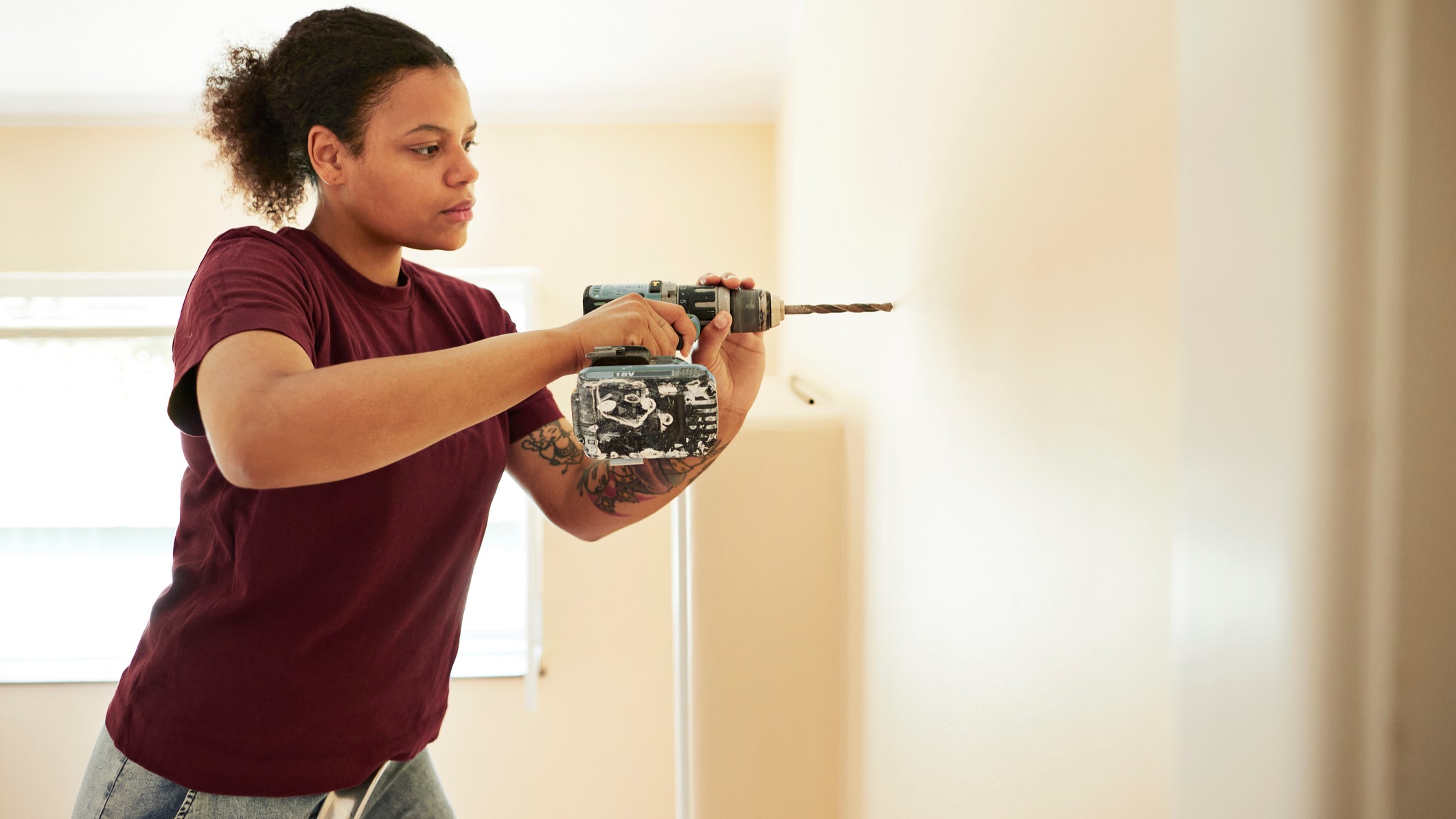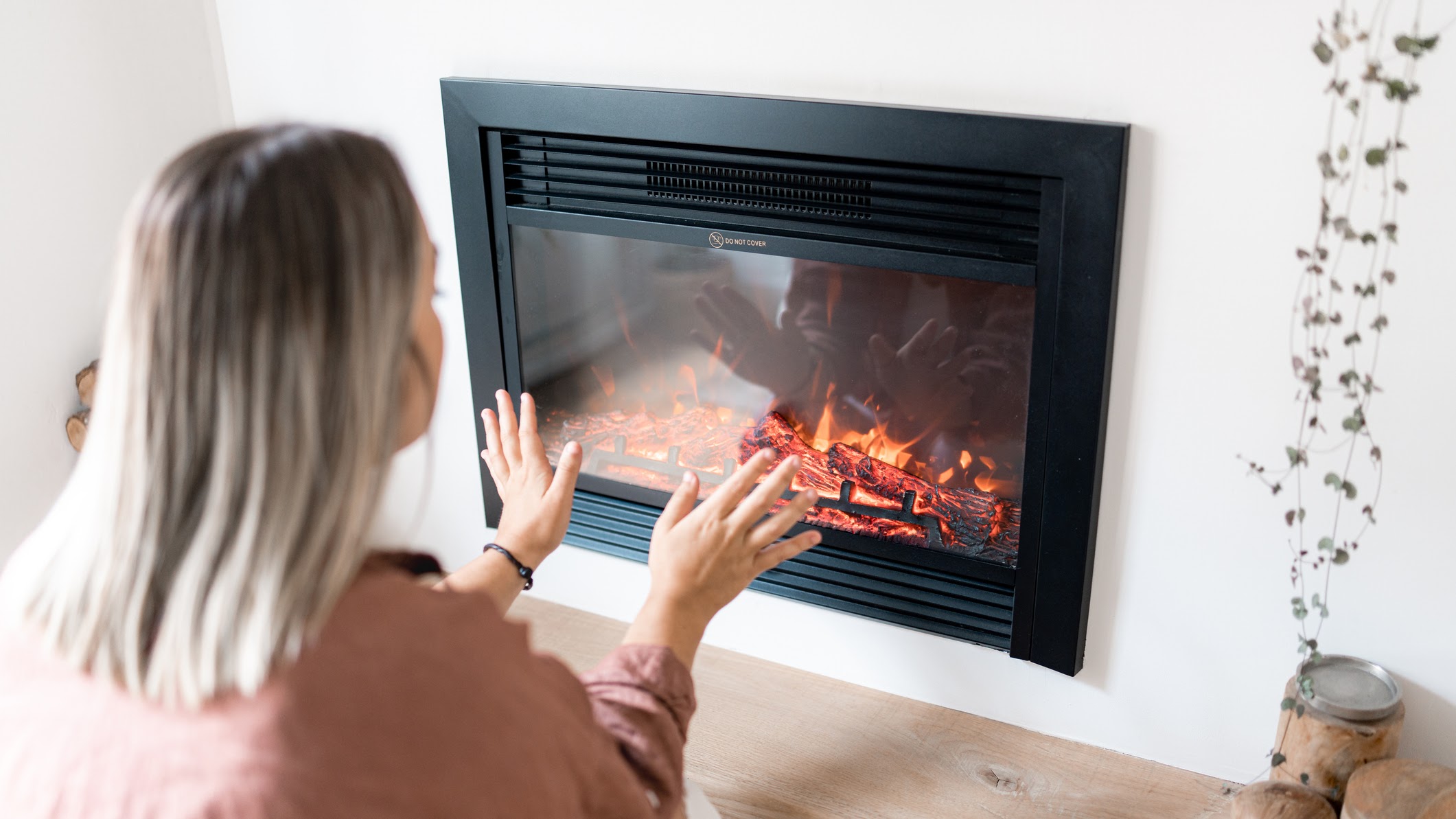- Combi drill
- Wall plugs and screws (these are often provided)
- Tape measure
- Oscillating multitool with plunge-cutting blade (optional, for removing baseboard)
- Caulk or filler
- Electrical safety gloves
Before you begin installation, it’s important to review local codes or regulations governing the use and installation of electric fireplaces in a domestic context. This will ensure your installation can be safe and compliant.
“Always check with your local authority having jurisdiction (AHJ) first to determine which code variant they are using and whether permits and inspections are needed,” says Braden Welch, a Virtual Electrical Expert at Frontdoor.

Braden Welch is a virtual electrical expert at Frontdoor, a homeowner advice provider. The Frontdoor team offers 24/7 advice on home and garden issues, including electric fireplace installation.
How to install an electric fireplace: quick steps
- Choose model and placement
- Assess electrical requirements
- Connect electrics
- Fit the fireplace
- Finishing touches
How to install an electric fireplace: Step by step guide
Disclaimer
*Installing an electric fireplace can be dangerous. Before you start, safely turn off all relevant electricity supplies from your consumer unit.*
1. Choose your model and placement
The right electric fireplace can efficiently heat a space such as a lounge or dining room, but where you install the appliance and which model you choose will affect its performance.
Central placement within the room will ensure the fireplace distributes heat evenly throughout the space. Pick a spot that can be a focal point, such as a wall section near a sofa or dining table. A safe clearance should be between the fireplace and flammable objects or materials.
Once you’ve chosen a location, you can choose an electric fireplace. Freestanding models tend to be easiest to install, while wall-mounted models like the eFlame Sundance ($169, Amazon) are an elegant alternative that requires a little more effort due to their use of wall-mounting brackets.
Before you buy an electric fireplace, check its heat output to ensure the heating provided is sufficient for the room size.
Disclaimer
*The following step may require expert input from an electrician.*
2. Assess electrical requirements

Check whether your household electrical circuits can accommodate your chosen electric fireplace. Then, identify a power outlet close to the fireplace that is not currently used to deliver electricity to high-powered appliances.
“First, be sure you know the circuit load you are potentially going to use,” says Braden.
“If the load is too close to the maximum rated amperage of the wire/breaker (factoring in everything that you typically plug into outlets using that circuit), then a dedicated circuit will need to be run from your electrical panel, just for the fireplace,” he says.
“Be aware that heating elements pull a lot of amperage, so the voltage range on the fireplace would be 120V/240V.”
Most homeowners will need the help of a professional electrician for this step, especially if a new electrical circuit needs to be run to the fireplace's location.
Disclaimer
*Altering electrical circuits is a job for professionals. If you need to do this, get help from a qualified expert.*
3. Electrical connections
We’re now starting the hands-on work of installing an electric fireplace. Turn off the household electricity supply to the relevant room in your control box for your safety. Throughout the rest of the process, you can use a battery-powered light (or daylight) to see what you’re doing.
Some electric fireplaces come with a power plug that can simply be plugged into a power outlet, whereas others have exposed wires that may need to be connected directly to the household electricity circuit.
“If you have determined there is enough safe space on the circuit and the electric fireplace features just a regular plug, then there’s no preparation needed – just plug and enjoy,” says Braden.
“However, if your new electric fireplace has a power lead with loose wires at the end, this will need to be terminated at a nearby outlet.”
“If the fireplace needs a new circuit, then it’s more than likely the wire will just be free floating. Anytime a wire is not in the wall, it must be protected. I would recommend a small piece of metal-clad (MC) wire from the wall to the fireplace,” he adds.
4. Fit the fireplace

Position it in its intended location without turning on the electric fireplace or connecting it to a power source.
Freestanding electric fireplaces are very easy to fit. You may need to secure it to the wall with a few safety screws using a combi drill to ensure the appliance cannot topple forwards (an important safety feature for families with small children and pets). Apart from that, you can pretty much just shuffle the fireplace into position against the wall.
Use your combi drill to install the mounting brackets according to the manufacturer’s instructions for wall-mounted electric heaters. Then, lift the fireplace onto the brackets and secure it in place.
If you need to fit your electric fireplace against the wall, you may need to first remove a section of the baseboard (AKA skirting board). Measure the length of the baseboard section that needs to be removed, then use an oscillating multitool with a plunge-cutting blade to cut precisely through the wood. Carefully lever away the unwanted central section of the baseboard so that the electric fireplace can sit neatly in the gap.
If you do not want to remove any baseboards, look for a freestanding model that can be a little removed from the wall, a wall-mounted model, or one of the best baseboard heaters.
5. Finishing touches
With your electrics prepared and your fireplace in position, you’re ready to enjoy a warmer home.
If your electric fireplace is supposed to fit flush with your wall and/or skirting boards, you might want to apply some caulk or filler (following the product instructions) around the edges where the appliance meets a surface. This will create a seamless, inset appearance.
How to install an electric fireplace: FAQs
Can I install an electric fireplace without professional help?
Many homeowners install their electric fireplaces, but the specific steps required for some models should be left to a professional electrician.
“It depends on how comfortable you feel with all the factors needed to complete the job,” says Braden.
“If a new circuit needs to be run, that can be tricky for the average homeowner. The difficulty level varies depending on the fireplace's location, how far from the panel, and whether there is space in your panel for a new circuit to be fitted.”
With that said, if your electric fireplace can simply plug into an existing power outlet, then there’s a good chance you can carry out installation independently.
What differences between electric fireplace models can affect installation requirements?
“There are some things to consider when reviewing different models of fireplaces, including the installation needs,” says Braden.
“Some models require a 120V circuit, and some require a 240V circuit. Some have a traditional plug you just plug into a wall outlet, whereas others need to be hardwired (or in some cases, you can hardwire in an appliance cord that's appropriately rated for the fireplace and plug it into a wall outlet).
“Always carefully review the manufacturer’s specifics and installation guides,” he adds.
Of course, freestanding and wall-mounted models have different fitting processes.

Fitting an electric fireplace can be dangerous if you do not have the required skills and knowledge, especially if a new electrical circuit or hardwiring is required. If you are unsure of what to do during the installation process, contacting a qualified expert for advice or further support is highly advisable.

